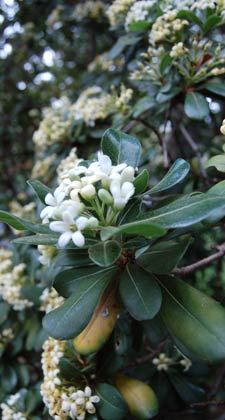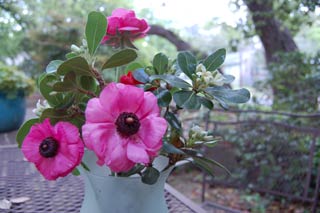Human Flower Project
Wednesday, March 28, 2007
Pittosporum: Here to Stay
Fragrant, shiny, shieldy, dog-proof, what’s not to like about this beauty?
 Pittosporum tobira
Pittosporum tobira
March 28, 2007
Photos: Human Flower Project
Our first—and, to date, only—advice from a garden designer several years back was not a disaster, only because we paid this person for his time and then ignored everything he’d said. Our place definitely needs design triage but we’re shy, bordering on design-phobic, after such a brush with inanity.
We had a nice preliminary chat with the fellow who’d been recommended to us and about a month later received several scrolled up blueprints (?). Unfurling them, we saw lots of circles, that weird calligraphy they must teach in architecture school, a list of botanical names and numbers, and a drawing that looked like something you’d see at the entrance of a golf course in Palm Springs. This could be ours for roughly $10,000.
Now certainly we were at fault. Or/and we must have been body snatched by the spirit of Nancy Reagan during that conversation with the designer, for how else could our rattling on about the wildflowers of Peloponnesia have been converted into this?
Being greatly the coward before authority figures of all kinds, we ordinarily would have tried compromise: “Could we possibly have the $1000 version of Swastika Estates?” except for one thing. This fellow wanted to chop out the pittosporum tree. In fact, he really insisted. “It will clean up all the lines and enhance the view of your oaks,” he told us.
‘Fraid not.
 With ranunculus
With ranunculus
The old gnarly pittosporum must have been planted 30 or more years ago. It’s grown up around and underneath a mott of older live oaks and makes a wonderful screen on the street side of our little bumpy patio. And it’s beautiful, especially this time of year. The tree is in full bloom, covered with clusters of white blossoms that smell sweet and citrusy. E.B. Castro, a renowned florist in San Antonio, told us that pittosporum has long been a signature of his arrangements. Not only are the blossoms delicate and fragrant, the leaves spray apart in shiny green starbursts. As a cut flower, it possesses many of the virtues of magnolia but without the plantation-scale.
We’ve learned there are 200 species of flowering plants in this family and, as usual, aren’t sure what’s growing here. Our best guess is Pittosporum tobira, a native of Japan. It’s long been popular throughout Florida and the Gulf Coast. For lots more about this plant, including how to grow one, please check this thoroughgoing entry.
This author too makes note of pittosporum as a “filler” flower. “In 1983, the last year for which a published estimate is available, Japanese pittosporum accounted for about 5% of the U.S. cut foliage market.”
 Gaston, an 11-year old Catahoula,
Gaston, an 11-year old Catahoula,
companion animal for pittosporum
Anyone who enjoys arranging flowers will like this article about using woody ornamentals. There’s quite a list of shrubs, trees and other plants you may not have considered cutting and bringing indoors—and of course, pittosporum makes the cut.
Finally, we should note that, unlike many delicate garden flowers, this hardy plant goes well with dogs, a significant feature for many of us. You may note in this photo, taken today with a new friend in the neighborhood, that pittosporum branches, like some magnolias, have the graceful habit of reaching down, as well as up, to bloom.
Last year, we saw that a volunteer pittosporum had sprouted in a shady bed beside the house. Seems today’s the day to dig that youngster up and plant it where it may thrive—no thanks to the experts.




